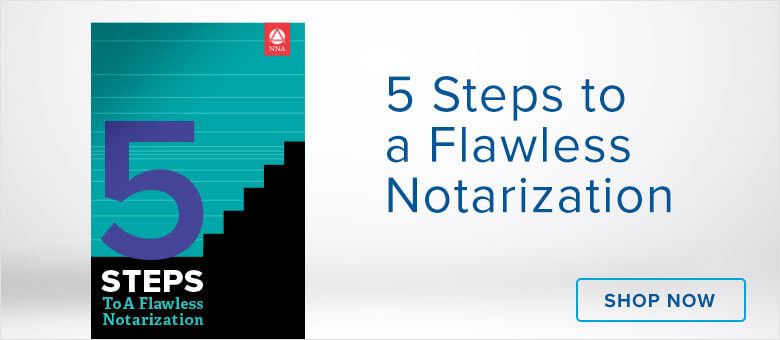
Only a few states give new Notaries practical tips for notarizing documents properly. Even states that have mandatory education requirements for commission applicants focus more on Notary law than Notary practice.
To help the new Notaries in our community, here’s how to notarize a document in 5 steps:
- Require personal appearance
- Check the document
- Carefully identify the signer
- Record your journal entry
- Complete the notarial certificate
Below, we’ll review each of these steps in notarizing a document and explain why they’re important for protecting your clients, and also yourself from any potential issues.
Step 1: Require personal appearance
Almost every state requires the signer to personally appear before you during the notarization. That’s crucial because it helps protect your signer, your employer, anyone relying on the notarization and you against potential fraud and liability.
Personal appearance allows you to complete other steps in a proper notarization.
Many states now permit Notaries to perform notarizations using audio and video conferencing technology — via remote online notarization.
Step 2: Check over the document
You should always check over the document you are notarizing for a number of important reasons:
- To look for certificate wording that will tell you what type of notarization to perform.
- To review the certificate wording to make sure it contains all the elements a Notary certificate should have and that it conforms to the requirements of your state.
- To check for blank spaces. Some states mandate there are no blanks on a document and other states just strongly recommend it. Blank documents can be altered later in an attempt to commit fraud.
- Be sure to enter the date the notarization took place in the certificate wording.
- To verify that the name on the ID supports the name in the document.
Scanning the document does not mean reading it for its details. You should just glance over it sufficiently to get the information you need.
Remember, never give legal advice. Many signers will ask you for advice or assistance regarding their document. Unless you are an attorney, you should always say no because it would be the unauthorized practice of law, and you could be held liable.
Step 3: Carefully identify the signer
Properly verifying your signer’s identity is the essential duty of every Notary. Every state provides some direction as to how to identify your signer, and there are 3 general methods:
California does not allow Notaries to rely on personal knowledge to identify signers. Instead, California Notaries must rely either on one of the forms of signer ID permitted by state law, or credible identifying witnesses if the signer lacks other forms of acceptable identification.
Identifying the signer is always required when taking an acknowledgment of a signature and may be required when you perform a jurat, verification upon oath or affirmation, or affidavit; it’s also recommended when you certify a copy.
At this point, make sure your signer is acting of their free will and is aware of what’s going on. You can do this with small talk and basic questions. When it comes to a signer’s awareness, it’s recommended that you simply make a layperson’s judgment about the signer’s ability to understand what is happening.
Some states, such as Florida, specifically prohibit notarizing if the signer appears mentally incapable of understanding the document. Texas authorizes Notaries to refuse a notarization if the signer appears under coercion, the Notary has reason to believe the document may be used for an illegal purpose or the signer does not understand the document, or if the Notary is not familiar with the type of notarization requested.
Then take the signer’s acknowledgment, witness the signature, and/or take the oath or affirmation as required by the notarial act.
Step 4: Record your journal entry
Most states either require or recommend Notaries maintain a record of all notarizations. A good Notary journal entry contains details of the notarization that are helpful in case a document or notarization is called into question.
It’s generally a good idea to complete your journal entry before the notarization so you can ensure that you collect all the necessary elements of the record, including your signer’s signature.
Step 5: Complete the notarial certificate
If the document does not contain certificate wording, ask your signer what type of notarization is required and then attach a separate, or loose, Notary certificate.
Many signers do not know what type of notarization they need so you may describe the different types, but you may not make the decision for the signer unless you are a licensed attorney. If your signer is still uncertain, he or she should contact the issuing or receiving agency for instructions.
When completing the certificate, make sure all the details are correct. For example, the venue — or location of the notarization, indicated by the words “State of … County of …” — should be where you performed the notarization, not where the document was prepared or will be filed.
Finally, take care to sign and affix your seal properly. You should always sign exactly as your name appears on your commission. Your seal should be close to your signature but should not overlap any wording. The goal is to make everything legible. If you are in a state that does not require you to use a seal, you may need to add your name and commission information in other spaces below your signature.
Notarize with confidence
NNA members enjoy access to our NNA Notary Hotline where you can have your most specific or unusual Notary questions answered in real-time.
Instead of risking an error during signing, NNA membership allows you to notarize with confidence knowing that you’ll have access to our experts who are ready to answer your state-specific questions.


Related Articles:
The most common types of notarizations
When to say 'No' … and when refusing a notarization is not allowed
Additional Resources:
NNA Hotline